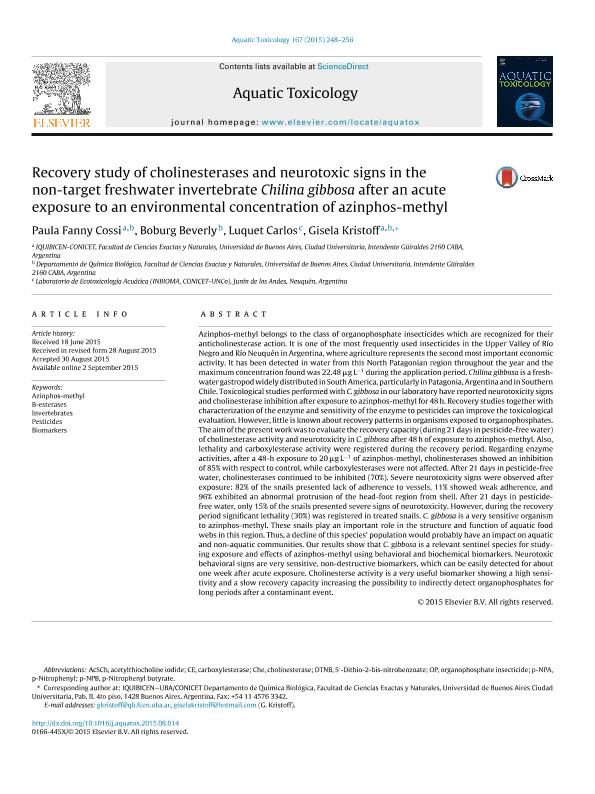Mostrar el registro sencillo del ítem
dc.contributor.author
Cossi, Paula Fanny

dc.contributor.author
Boburg, Boburg
dc.contributor.author
Luquet, Carlos Marcelo

dc.contributor.author
Kristoff, Gisela

dc.date.available
2017-04-12T19:37:04Z
dc.date.issued
2015-09
dc.identifier.citation
Cossi, Paula Fanny; Boburg, Boburg; Luquet, Carlos Marcelo; Kristoff, Gisela; Recovery study of cholinesterases and neurotoxic signs in the non-target freshwater invertebrate Chilina gibbosa after an acute exposure to an environmental concentration of azinphos-methyl; Elsevier; Aquatic Toxicology; 167; 9-2015; 248-256
dc.identifier.issn
0166-445X
dc.identifier.uri
http://hdl.handle.net/11336/15236
dc.description.abstract
Azinphos-methyl belongs to the class of organophosphate insecticides which are recognized for their anticholinesterase action. It is one of the most frequently used insecticides in the Upper Valley of Río Negro and Río Neuquén in Argentina, where agriculture represents the second most important economic activity. It has been detected in water from this North Patagonian region throughout the year and the maximum concentration found was 22.48 μg L−1 during the application period. Chilina gibbosa is a freshwater gastropod widely distributed in South America, particularly in Patagonia, Argentina and in Southern Chile. Toxicological studies performed with C. gibbosa in our laboratory have reported neurotoxicity signs and cholinesterase inhibition after exposure to azinphos-methyl for 48 h. Recovery studies together with characterization of the enzyme and sensitivity of the enzyme to pesticides can improve the toxicological evaluation. However, little is known about recovery patterns in organisms exposed to organophosphates. The aim of the present work was to evaluate the recovery capacity (during 21 days in pesticide-free water) of cholinesterase activity and neurotoxicity in C. gibbosa after 48 h of exposure to azinphos-methyl. Also, lethality and carboxylesterase activity were registered during the recovery period. Regarding enzyme activities, after a 48-h exposure to 20 μg L−1 of azinphos-methyl, cholinesterases showed an inhibition of 85% with respect to control, while carboxylesterases were not affected. After 21 days in pesticide-free water, cholinesterases continued to be inhibited (70%). Severe neurotoxicity signs were observed after exposure: 82% of the snails presented lack of adherence to vessels, 11% showed weak adherence, and 96% exhibited an abnormal protrusion of the head-foot region from shell. After 21 days in pesticide-free water, only 15% of the snails presented severe signs of neurotoxicity. However, during the recovery period significant lethality (30%) was registered in treated snails. C. gibbosa is a very sensitive organism to azinphos-methyl. These snails play an important role in the structure and function of aquatic food webs in this region. Thus, a decline of this species? population would probably have an impact on aquatic and non-aquatic communities. Our results show that C. gibbosa is a relevant sentinel species for studying exposure and effects of azinphos-methyl using behavioral and biochemical biomarkers. Neurotoxic behavioral signs are very sensitive, non-destructive biomarkers, which can be easily detected for about one week after acute exposure. Cholinesterse activity is a very useful biomarker showing a high sensitivity and a slow recovery capacity increasing the possibility to indirectly detect organophosphates for long periods after a contaminant event.
dc.format
application/pdf
dc.language.iso
eng
dc.publisher
Elsevier

dc.rights
info:eu-repo/semantics/openAccess
dc.rights.uri
https://creativecommons.org/licenses/by-nc-nd/2.5/ar/
dc.subject
Azinphos-Methyl
dc.subject
B-Esterases
dc.subject
Invertebrates
dc.subject
Pesticides
dc.subject
Biomarkers
dc.subject.classification
Otras Ciencias Químicas

dc.subject.classification
Ciencias Químicas

dc.subject.classification
CIENCIAS NATURALES Y EXACTAS

dc.title
Recovery study of cholinesterases and neurotoxic signs in the non-target freshwater invertebrate Chilina gibbosa after an acute exposure to an environmental concentration of azinphos-methyl
dc.type
info:eu-repo/semantics/article
dc.type
info:ar-repo/semantics/artículo
dc.type
info:eu-repo/semantics/publishedVersion
dc.date.updated
2016-12-12T14:32:48Z
dc.journal.number
167
dc.journal.pagination
248-256
dc.journal.pais
Países Bajos

dc.journal.ciudad
Amsterdam
dc.description.fil
Fil: Cossi, Paula Fanny. Consejo Nacional de Investigaciones Científicas y Técnicas. Oficina de Coordinación Administrativa Ciudad Universitaria. Instituto de Química Biológica de la Facultad de Ciencias Exactas y Naturales; Argentina. Universidad de Buenos Aires. Facultad de Ciencias Exactas y Naturales. Departamento de Química Biológica; Argentina
dc.description.fil
Fil: Boburg, Boburg. Consejo Nacional de Investigaciones Científicas y Técnicas. Oficina de Coordinación Administrativa Ciudad Universitaria. Instituto de Química Biológica de la Facultad de Ciencias Exactas y Naturales; Argentina. Universidad de Buenos Aires. Facultad de Ciencias Exactas y Naturales. Departamento de Química Biológica; Argentina
dc.description.fil
Fil: Luquet, Carlos Marcelo. Consejo Nacional de Investigaciones Científicas y Técnicas. Centro Científico Tecnológico Patagonia Norte. Instituto de Investigación En Biodiversidad y Medioambiente; Argentina
dc.description.fil
Fil: Kristoff, Gisela. Consejo Nacional de Investigaciones Científicas y Técnicas. Oficina de Coordinación Administrativa Ciudad Universitaria. Instituto de Química Biológica de la Facultad de Ciencias Exactas y Naturales; Argentina. Universidad de Buenos Aires. Facultad de Ciencias Exactas y Naturales. Departamento de Química Biológica; Argentina
dc.journal.title
Aquatic Toxicology

dc.relation.alternativeid
info:eu-repo/semantics/altIdentifier/url/http://www.sciencedirect.com/science/article/pii/S0166445X15300400
dc.relation.alternativeid
info:eu-repo/semantics/altIdentifier/doi/http://dx.doi.org/10.1016/j.aquatox.2015.08.014
Archivos asociados
